The third Global Police Tweet-a-thon is just behind us. According to Bright Planet the third #poltwt saw over 15,000 original tweets from 1,000 unique users. A map of the officially registered users is on Google.
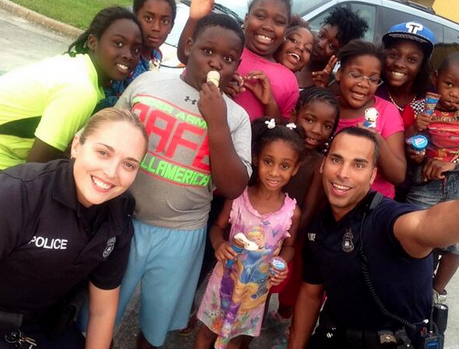

The third Global Police Tweet-a-thon is just behind us. According to Bright Planet the third #poltwt saw over 15,000 original tweets from 1,000 unique users. A map of the officially registered users is on Google.
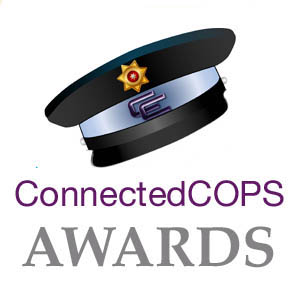
This award is given to a law enforcement agency, anywhere in the world, of 151 sworn officers or more that has demonstrated overall excellence in the use of social media to enhance its services to the public. The agency exhibits leadership, creativity and innovation in its use of social media to engage, educate, recruit, and etc. The agency has a broad and deep understanding of social media use and applies sound governance and strategy in its social media operations. The agency also promotes the use of social networking in law enforcement through its outreach to colleagues and by mentoring others.
We have three finalists and they are:
Reykjavik Police, Iceland
Since it was founded in 2007 the Reykjavik Metropolitan Police (RMP) has worked to enhance the security and feeling of security among those who live, work or stay in the metropolitan area. To achieve this objective the RMP has focused on increasing the visibility of the police, increased information sharing and building a proactive community partnership. The RMP tapped social media at the end of 2010 and is rapidly accomplishing these goals as a result. With over 42,000 Facebook subscribers the RMP is connected to 20% of the population it serves. The RMP also makes very creative use of Twitter, Instagram, Flickr and YouTube.
Saanich Police, British Columbia, Canada
The Saanich Police Department (SPD) believes that the true essence of community engagement via social media is accomplished by empowering its agency’s members. The department’s newly established social media policy provides the ability for all agency members to reach the community. SPD supports and encourages specific units within the agency to engage on a personal level. SPD credits its social media program for ensuring that its messaging and community engagement activities are delivered in a clear, timely and responsible manner. With creativity and innovation the SPD has become a global leader with its use of social media.
Cape Coral Police, Florida, United States
Social Media is a major component of the Cape Coral Police Department’s (CCPD) Community Engagement Program. In order to achieve fundamental transformation and a significant shift in the direction that the Department was moving, the CCPD used a two-pronged approach. First, CCPD took back control of its presence on the web from a central city webmaster and went in a completely different direction. CCPD created a new website built around a blogging engine and tightly integrated with social media and optimized for searchability. The focus was on rich media, compelling content, useful information, and 2-way communication with citizens. Second, The CCPD Social Media Program focused on key social networks in order to maximize the reach of the agency’s message. The CCPD has focused on Facebook, Twitter, and Youtube to achieve its goals and become world leaders in police us of social media.
Winners will be announced September 25th at the SMILE Conference™ in Omaha, Nebraska.
Previously announced finalists:
The ConnectedCOPS Awards were created by LAwS Communications with the intent of recognizing the good work being done by individual officers and law enforcement agencies with social media. The international law enforcement community will be considered for these awards. Any officer or agency anywhere in the world is eligible.
The explosive growth of social media has been amazing to watch. As a former law enforcement officer I used social media during investigations to try and tap into the electronic street for information. Whether it was to track the whereabouts of wanted individuals or to try and catch a tidbit of information, social media often provides what you seek when properly used. Now, that I am retired, I am exploring new ways that LEOs can use social media to help solve more cases by using the existing tools that are already out there. The focus of this article is how law enforcement can use social media to help stoke interest in cold cases. I was surprised to see how many police department websites don’t have a page dedicated to missing persons and unsolved crimes.
Social media can play a bifurcated role in help solving cold cases. First, for the victim’s family, it keeps the case relevant. There is no better way to give the case life then injecting a fresh look at things. Birthdays, incident dates and holidays can all be used to garner information. Using social media also helps bridge the gap that develops in cold cases between the family and the police. It brings good will and a renewed interest. However, before I started any social media campaign for a cold case, I would ensure two things: 1) that the case has some solvability factors and 2) that I spoke with the family and explained what is happening before going live. Family members always want to see the case closed with an arrest, however, the emotions brought out when renewing the relationship weighs heavily on them.
For LEOs, social media provides a home base for the collection and dissemination of intelligence information for people that knew the victim(s), followed the case carefully and may be able to provide further information. It can also serve as a database of eyewitnesses that now may have scattered throughout the nation or identify ones that were originally reluctantly to come forward. With the many location finders on social media, investigators can save hundreds of hours tracking down people that were involved with the case. What is better than them coming to you? In essence, the social media page acts as an online memorial and tribute to the victim. They always seem to bring about chatter and conversations which may in turn provide a viable lead. It is important that the page be monitored and investigators should respond and engage comments posted on the site.
Whenever you create a website or post, you have to think about Search Engine Optimization (SEO). SEO is a tricky thing for non-techies like myself, so I will encourage you to read up on it. However, there are a few simple things that you can do so that your site gets the maximum attention from search engines. Make sure you include Tags and or Labels. Tags and Labels are the words that describe what is in your post and will be picked up by search engines and each platform, Blogger, WordPress, etc. calls them different things, but they have the same goal, optimization.
When designing a cold case page or post, ensure you include the following tags and or labels so that if anyone inputs the label in a search, your post will show up in the results:
Social media can help investigators garner new information and leads, however, it is still the mainstream media that drives the point home. Many cold cases come from the era that predated the Internet, so television news spots, newspapers and radio are still vital in investigations. That demographic cannot be ignored. Social media can be used to attract the mainstream media, which can gauge the public’s interest on a particular case and cover it, supplying law enforcement with the amount of exposure necessary to turn the heat up on cold cases.
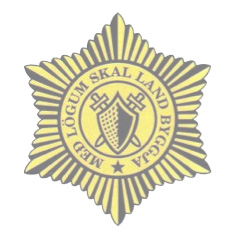 I wanted to thank you all for a very interesting group of people of which I consider to be at the forefront of new Policing – policing on a new digital front. My name is Thorir Ingvarsson, and serve as a a Detective Inspector for the Reykjavík Metropolitan Police (RMP) in Reykjavík, Iceland, and as of 1 June 2012 as the Social Media Manager. Prior to my appointment, I was a detective in the homicide/ sexual offences unit in Reykjavík.
I wanted to thank you all for a very interesting group of people of which I consider to be at the forefront of new Policing – policing on a new digital front. My name is Thorir Ingvarsson, and serve as a a Detective Inspector for the Reykjavík Metropolitan Police (RMP) in Reykjavík, Iceland, and as of 1 June 2012 as the Social Media Manager. Prior to my appointment, I was a detective in the homicide/ sexual offences unit in Reykjavík.
First, a little bit about Iceland and its police force. Iceland is situated in the middle of the Atlantic Ocean, equidistant between America and Europe. It´s a small country with an area of 103,000 km2 (40,000 sq mi) and a population of around 320,000 people. The Icelandic police serve on a federal level with approximately 650 police officers. There are 15 local police districts throughout the country, each having its own police commissioner. The Reykjavik Metropolitan Police are responsible for the largest police district in Iceland with 300 police officers and a population of more than 200,000 inhabitants. Iceland is one of the more sparsely populated countries in the world, but with one of the highest internet penetration in the world with over 97.8% internet penetration in Dec, 2011, according to the ITU.
In December 2010 the RMP opened up its Facebook site, being the first of the Icelandic police forces to do so. The site caught the attention of the Icelandic public and after one year of operation the Facebook site had 13,000+ fans and became a very active site posting, and more importantly – communicating with the public. This was due to a number of factors. First of all Facebook has a very high penetration count in Iceland, having over 222,000 registered Facebook accounts. Another factor being that the Icelandic police has always been an unarmed police force, one of the very few in the world, living in a small society; having a good relationship with the public being of utmost importance.
When the RMP´s Facebook site was opened the site was run by Police Commisioner Stefán Eriksson and Detective Thorir Ingvarsson. Soon the administrator group was expanded and now a group of 12 people have administrator privileges to the site. A private admin group was created on Facebook where the administrators can speak amongst themselves, discussing areas such as how to tackle various problems that come up. This is extremely important seeing that the speed of communication does not allow for a long response time and waiting for face time with the admin group would take far too long. The group members have several roles, those working in the field are encouraged to post on topics related to their daily work, especially the brighter sides of police work. Others have the responsibilities of moderation of the discussions and posting of press releases and such, as had been done before, but now getting a channel straight to the public, in a way, bypassing the conventional media.
The feeling amongst the group has been that now a direct line of communication has been opened to the public, where the police can publish, yet also engage with the public giving it a whole new dimension; the material gaining life of its own, being discussed, criticized or praised by the public. The public has been very happy with this new step in policing in Iceland and as of August 2012 the RMP´s Facebook site reached 23.000 fans – and is still rising.
On the 20th of June 2012 the RMP opened its Youtube channel, taking its first steps in building a platform to be able to broadcast its material. The material published there will at first be short infomercials created by the Icelandic traffic authority, which had previously been posted through the RMP´s Facebook site from time to time. Now the RMP has a platform in which it can link and use with their Facebook account, and publish material from partners, such as the traffic authorities but also creating a possibility for innovative employees who would see a chance to produce material suitable for police use on YouTube, e.g. with outside funding, such as non-profit organisations. Two weeks after its launch the channel now has 55 subscribers and just shy of 900 views. The scheduling of new material will hopefully begin this autumn but now enough material is available so that the site will, at least, post a short traffic video every two weeks until May 2013.
On the 25th of June 2012 a first in Icelandic policing was achieved when the RMP´s Facebook site published a post stating the whereabouts of an unmarked car with a traffic camera, that is, where that traffic camera would be situated that day. This was done to enhance the preventive nature of speed enforcement cameras used in the area and increase the awareness of these cameras to the public. This has caused an extensive amount of interesting dialogue with the public through the RMP Facebook site, even people discussing whether speed enforcement cameras are the right way to police. Overall this has been met with great enthusiasm from the public. There have been a large number of communications coming into the RMP from the public requesting that the cameras be positioned near their home, neighborhood or other places where they feel the need to bring speeds down. To enhance the effect of these posts, they are then followed by a comment at the end of the day, stating what result this speed enforcement yielded. This has also been very well received and gives the public information regarding whether this is truly paying off. A typical post at the beginning of the day would look like this:
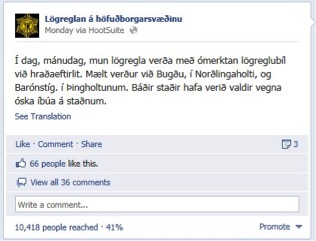
Translation: Today, Monday, police will monitor speed using an unmarked police car. The speed check will be performed at Bugðu, in Norðlingaholt, and Barónstíg, in the Þingholt. (street names and areas). Both locations have been chosen due to request from the inhabitants close to these locations.
At the end of the day another posting is made:

Translation: 13 offences were recorded today at Bugða in Reykjavík. Vehicles traveling east Bugða, at Kólguvað in Norðlingaholt, were monitored. In one hour, after noon, 24 vehicles drove past and a majority (54%) of these were going too fast. The average speed of those offenders was 45 km/hr but at that location there is a 30 km/hr max speed. The one traveling the fastest was driving at 54 km/hr.
It will be very interesting to follow how the public will relate to these posts and the information given in them. Bearing in mind that the unmarked police vehicle with the speed camera has been in use for a number of years; and therefore data on previous behaviour is available and is usable to determine if there is a change in the behaviour of the drivers in these spots.
There is no shortage on ideas, Because of the extraordinary support from the chief, I see the social media project taking the RMP further and providing an excellent opportunity for engagement in times where the police has less time for communication using conventional ways. One can also argue that the idea of the police officer walking his or her beat, could actually be tranfered into a digital reality where the public are spending more and more of their time. In addition to thinking of more ways for the public to engage with its police force, to ask, to give opinions and to make recommendations on how the police operate strengthening the ties and empowering the public.
In the next months the RMP will further explore how Social media can serve as a good tool in the policing toolchest. We will keep you informed.
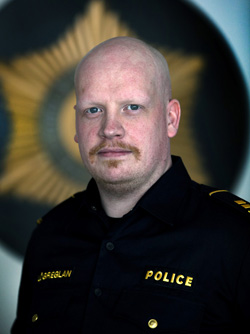
Thorir Ingvarsson, is a Detective Inspector for the Reykjavík Metropolitan Police (RMP) in Reykjavík, Iceland. The Reykjavik Metropolitan Police Force is a finalist in the Large Agency category for the ConnectedCOPS Awards. Winners will be announced on September 11th, in Richmond, VA at The SMILE Conference™.
 Social Media participation not only allows engagement within, but also well beyond your community and may offer benefits not readily available in times past. A blog devoted primarily to “cold case” investigations reached out and engaged with the Arcadia Police Department, highlighting the unsolved 2007 Jason Wei murder case in March of this year. Defrosting Cold Cases (DCC) is the name of this blog, developed and managed by an east coast lawyer who is known as @Vidocq_CC on Twitter. “My work got me in touch with many police departments and those collaborations resulted in this website. I have yet to find a police department that is not underfunded, not understaffed, or not overworked. Often, I heard officers say that they wished that they had time to build a website for their cold cases…”
Social Media participation not only allows engagement within, but also well beyond your community and may offer benefits not readily available in times past. A blog devoted primarily to “cold case” investigations reached out and engaged with the Arcadia Police Department, highlighting the unsolved 2007 Jason Wei murder case in March of this year. Defrosting Cold Cases (DCC) is the name of this blog, developed and managed by an east coast lawyer who is known as @Vidocq_CC on Twitter. “My work got me in touch with many police departments and those collaborations resulted in this website. I have yet to find a police department that is not underfunded, not understaffed, or not overworked. Often, I heard officers say that they wished that they had time to build a website for their cold cases…”
Our Department had teamed up with the Los Angeles County Board of Supervisors, gathering a $20,000 reward in this case which was previously promoted through conventional media. Having a web presence like DCC highlight the case, and by using Social Media platforms, only multiplies our efforts to bring awareness to the Wei case. There are virtually no limits to potential exposure on the Internet and this is a great example of using Social Media as a force multiplier.
DCC is no stranger to collaboration efforts, as shown on their website. DCC benefits from the participation of NYPD Detective Sergeant Joe Giacalone who heads up the Bronx Cold Case Squad. Joe is active on the LexisNexis Investigators Network and hosts the Cold Case Squad Blog. DCC even reaches out globally, inviting UK fingerprint expert, Richard Case, to participate and offer additional expertise at the table. Penn State University has also contributed, offering assistance on a 1975 Florida cold case.
Honoring National Police Week, DCC recently ran a series of posts featuring some “ very alive” members of Law Enforcement that contribute to the conversation via Social Media, to include Captain Mike Parker, Los Angeles County Sheriff’s Department (CA), retired Suffolk County Police Department (NY) veteran Kathleen Ryan, Arizona Detective Suzy Ivy, Detective Sergeant Joe Giacalone, New York Police Department (NY), and Sergeant Tom Le Veque, Arcadia Police Department (CA). DCC also posted information on unsolved line of duty deaths, like that of the killing of Police Officer Robert Tatman, Champaign, IL, who was murdered in 1967.
For those of you who participate on Twitter, DCC and @Vidocq_CC host a frequent chat on Twitter, Fridays, noon to 1:00 p.m. EST, using the hashtag of #CClivechat. You can find various representation from folks that have an interest in law enforcement, crime, criminology, cold case investigation, writers, educators, lawyers, and more. Take a look at Defrosting Cold Cases and see if you, too, can take advantage of this type of force multiplier via Social Media.
